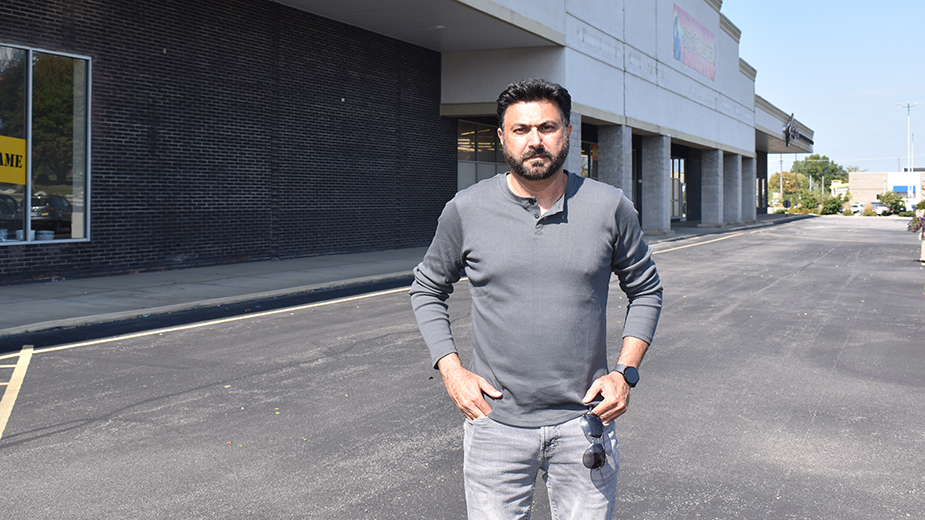BOARDMAN, Ohio – Boardman Center Plaza, positioned at the heart of Boardman’s sprawling commercial district, should be a more successful property than it is, according to its new owner, Tom Punjwani.
He aims to change that.
“When I looked at the center, I just fell in love with this location,” he says.
Punjwani, based in Texas, says he has a $60 million portfolio of properties – which he owns solely or in partnerships – primarily in Texas, as well as in Ohio and New York.
Boardman Center LLC, a company the real estate investor and developer formed, acquired the plaza in April for $4.5 million. Punjwani says he searches for assets that are physically or financially distressed, acquires them and works with local real estate agents and teams to re-tenant the properties.
“So I found this opportunity. I looked at the traffic count. Everything was excellent,” he says. The center was even getting “a good amount of interest” from a mix of potential tenants.
With some reinvestment in the property, Punjwani says he saw no reason that national tenants wouldn’t be interested. His goal for such properties is to have about 60% national and regional tenants, the remainder local tenants.
The plaza is on the west side of Market Street, south of U.S. Route 224 and across from Southern Park Mall. On a daily basis, 24,000 vehicles drive north and south through the Market Street-Route 224 intersection and 38,000 drive east and west through it, according to Don Thomas, owner/partner at Platz Realty Group, who is working with Punjwani to re-tenant the property.
Roughly half of the 136,000-square-foot plaza is vacant, Punjwani says.
Tenants include Rick’s Boot Factory Outlet, Harbor Pets, Guitar Center and Legends Food & Drink. A Spirit Halloween store is temporarily using the space once occupied by Murphy’s Mart, which later became Ames Department Store, and more recently JoAnn Fabrics & Crafts.
Punjwani acknowledges he expected that within his first six months of ownership he would have “at least four or five” sets of eyes on the center. That hasn’t been the case.
He dismisses the notion that economic worries account for the lack of interest and points to strong interest in properties he owns in other markets.
Punjwani also points to the presence in the local market by national operations. “I know that a lot of places are around here. But look at how cluttered they are on the street,” he says. He has never seen a Home Depot open in a location such as the one in Boardman, with its “difficult” ingress and egress.
“So why not this shopping center? We’ve got good space here. We’ve got good traffic. I’ve got a presence on a major intersection, one of the highest in Ohio traffic-wise,” he says.
Punjwani offers the example of a center he acquired in Texas that was about 40% occupied. He built occupancy to 80%. A video store chain that was going to occupy the vacant property instead purchased it for triple what he paid for it.
Part of Punjwani’s approach for the plaza will involve creating a second set of storefronts on the west-facing, rear of the property, space historically used by retail tenants to store inventory. Now the trend is for keeping less merchandise in stock, at least in large volumes like when Boardman Center and similar plazas were built. Spaces such as the one formerly occupied by JoAnn Fabrics likely will be subdivided for multiple tenants rather than occupied by a single large retailer, he says.
Punjwani plans to invest about $600,000 to upgrade the center.
“Large retail is not swinging the bat very hard,” Thomas observes. “When you reduce that square footage, it really opens up the options.”
The backside spaces would be attractive to tenants such as day care centers that don’t require the frontage and visibility that retail and restaurant tenants need, Punjwani says. He can charge at least $5 or $6 per square foot, in contrast with the $10 to $15 he can seek for more visible space.
“So, per square feet, I can generate more income out of it,” he says.
The growing service sector represents another potential source of tenants. Another possible use for vacant space is an indoor pickleball court.
Punjwani and Thomas say they are close to signing a tenant for a 16,000-square-foot space – just under a third of the space now vacant.
“It’s exciting because it’s a venerable brand,” Thomas says. It will bring “a lot of good traffic to the center, which is always something that those kinds of places need.”
“I have very good faith that this is going to go,” Punjwani says. “Some properties are just slow.”
Pictured at top: Tom Punjwani, a Texas real estate investor, purchased the Boardman Center Plaza in April. He paid $4.5 million.
